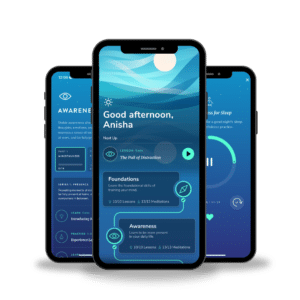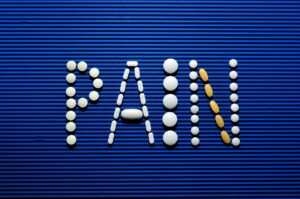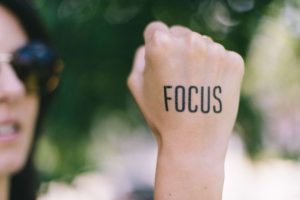- Grandparents Can Develop Activist Grandchildren - September 29, 2025
- Top Six Reasons Credit Union Benefits Are a Smart Choice Over Banks - August 18, 2025
- The Meaning of Equanimity: Discover How to Survive Challenges with Composure - June 9, 2025
Last Updated on January 17, 2025
Sometimes life is hard. Really hard. And we need mental health resources to keep us afloat. Fortunately, many resources are available to help us cultivate a healthier mindset and improve our mental well-being. I use the Healthy Minds app, a free, research-based mindfulness and mental health tool. In this post, I describe my experiences using the app.
Life Can be Hard
We all go through times when life is challenging. Whether that is related to your personal life or the work you do in the community, you might experience negative emotions, anxiety, and depression.
Activism can be challenging. Burnout symptoms include fatigue, trouble concentrating, sadness, anxiety, and poor performance. Getting burnt out is common for people who are not engaged and motivated in their activism. And that lack of engagement can lead to dropout, and the cause loses a dedicated person.
Burnout and dropout can result from:
- Doing tasks we really don’t enjoy doing, but we feel guilty if we don’t complete them for the cause.
- Being exposed to the traumatic experiences of others or even placing ourselves in danger.
- Not being supported by the people in our lives for doing activism or volunteer work.
- Spreading ourselves thin across many causes.
- Wondering whether we are really making an impact.
Another term for burnout is compassion fatigue. Read more about that problem in my post How to Use a Compassion Fatigue Test to Battle Burnout.
Although negative emotions such as disappointment, apathy, anger, and fear are a normal part of life, they are not good for our physical or mental health.
The Importance of Mental Health Resources
Mental health resources for well-being can take many forms, from therapy and counseling to support groups and online communities. However, with the rise of digital technology, many apps and online tools offer mental health resources and support.
Mental health resources like the Healthy Minds app can help you manage stress.
My Experiences with Other Methods

The science behind mindfulness and meditation for mental health is sound, so in the spirit of practicing what I preach, I tried to make meditation a regular part of my stress management plan. Still, I had difficulty finding the right option for me.
I faced issues like:
- I didn’t particularly appreciate sitting down to meditate. It was just too hard to concentrate, and I was stiff and achy when I finished.
- For a while, I tried lying down to meditate. But I often fell asleep. One could argue that sleep is good for you, but I wanted to meditate and stay in the present moment. And in my house, if someone is lying down, they are soon covered with a blanket of dogs.
- Another meditation technique I tried was mindful walking. I was more successful with this than other techniques because I like being outside, but I never made it a habit, either. If I was going for a walk, I had various people and animals who wanted to go with me.
The closest I got to staying in the present moment was yoga, where at least I was mostly paying attention to the instructions and how my body was feeling. The downside of yoga is that it takes time and the right place (without distractions) to do it properly.
The Healthy Minds App

The Healthy Minds app is a mental health resource for brain health. It is user-friendly and customizable.
The Healthy Minds app is free and research-based, created by a neuroscientist to train your mind for well-being. The app leads you through a series of lessons and practices. This sounds like many other meditation programs, but here, the lessons teach you about the science behind these practices.
These are the advantages that ended up being crucial for my success:
- You can set the length of time you want to meditate. The choices range from 5 to 30 minutes.
- They provide a choice of a seated practice or you can choose an active option.
- You can choose the speaker you want to guide you.
- You can also track how your brain health improves using the app.
After you perform a self-assessment, you will be led through the lessons and practices. The path you follow builds your skills by what they call the four pillars: awareness, connection, insight, and purpose.
Awareness
In this first section of the path, you learn to be in the present moment, get calm, and be focused. The practices strengthen your mindfulness, attention, and self-awareness.
Mindfulness is being present at the moment without judgment or distraction. It involves paying attention to your thoughts, feelings, and physical sensations. Being more mindful can reduce stress and anxiety, improve your focus and concentration, and increase your overall well-being.
Connection
In this section of the path, you practice strengthening your appreciation, kindness, and compassion. Again, the lessons show you why these are important to a healthy mind.
Insight
In the insight section of the path, you better understand how your thoughts and beliefs influence your emotions and reactions. Examining these areas helps you reduce stress and be calmer, even in difficult situations.
Purpose
In the final section of the path, you check what you want from your life and learn how to live your purpose and values.
If you use the app, you can expect to learn how to focus, be calm, understand how your mind works, improve your relationships with others, and gain a greater sense of your purpose.
My Experiences with the App

Five minutes is an utterly doable length of time for a beginner’s practice. Who can’t take 5 minutes for this, especially when you can fold your laundry simultaneously?
I listened to every lesson because it is important to me to understand the why behind the practice. The lessons are of varying length but usually last around 5 minutes. Understanding how the practices helped my brain kept me motivated.
Over time, I completed the entire program. Then, I started over and increased my practice time to 10 minutes. And wow, I could tell the difference in my meditation skills. I often skipped the lessons during my second round in the program but went through every practice again.
Some of the practices were more challenging for me than others. The insight section of the path was the most challenging for me as it involved self-inquiry and examining how the ways of thinking I have developed needed some tinkering. It helped reinforce how I interpret situations that arise and whether there is a healthier way to parse them and move forward.
Assessment
The assessment takes about 5 minutes, and the app tells you the results immediately.
You answer questions based on the 4 pillars of awareness, connection, insight, and purpose.
For example, How focused have you been? Do you notice your thoughts? What level of compassion do you feel for people, and do you take time to appreciate them? Are you living your purpose?
Since I have been using the app for a few years, I can look at my assessment profile and see how my scores have changed. Although my scores on “purpose” remain steady, my scores on “insight” vary a bit. This feedback tells me I still need to refine my skills in this area.
My New Skills Get Me Through a Crisis

I used several techniques that I learned from the Healthy Minds app to get through this ordeal.
First, I focused on my breathing, counting my breaths in and out, over and over again. This helped me relax, which reduced my anxiety and pain.
And second, I was able to control my cognitive reactions to being there. Instead of thinking, “I hate being here in the ER, having to run to the restroom, waiting such a long time when I’m in so much pain. It seems like me and the poor guy with kidney stones are the only really sick people here, why can’t we be seen first?”
Instead, I reframed the situation: “I am in the ER and know this is the best place for me right now. I’m sure the other people here are like me, wanting to get care quickly. The staff will care for me, and I will be okay.”
My husband commented later that he was amazed at how I made it through the 9 hours in the ER and the 8 days in the hospital. Controlling my emotions made me more resilient and patient during one of the worst times of my life.
Thank you, Healthy Minds app.
How to Use The Healthy Minds App
Once you have downloaded the app and completed the self-assessment, they will provide foundation practices to help you get started. Then, return to the app daily, and the next lesson or practice will pop up for you. At any time, you can change your settings. For example, if you don’t have much time to meditate, you can decrease the duration of the practice. Or, you can change from a sitting practice to an active one.
A Typical Practice Session
A recent practice I did was called “Beyond the Labels.” This practice is in the Insights portion of the path. This is a summary of the way I was guided through the practice.
The purpose of the practice is to explore what is beneath our labels and judgments.
Think of a word that describes how your body is feeling. I chose achy because I feel it in my joints before it rains.
Then, I was guided to consider the actual sensations throughout my body.
As I explored my bodily sensations more deeply, I went beyond the achiness in my shoulders and hands. My body felt pleasantly warm on this rainy day. I’m wearing my favorite comfy socks and shoes and sitting at my computer, which I’d set up to work perfectly for me. My comfy chair is at the perfect height. My ears are slightly cold, and my jaw is a bit tight. My eyes are getting natural light from the window, and I see trees off in the distance, moving in the wind. I hear my husband’s music from the family room. My ears are stopped up a bit and occasionally pop. As I take deep breaths that expand my ribcage, I smell ramen.
Then, I was prompted to explore the difference between how I labeled my body vs. exploring the sensations of my actual experience. Labels don’t capture rich, varied experiences. As a label, “Achy” masked some of the lovely sensations I was experiencing. My actual experience was infinitely more complex than my brain initially labeled it.
The app posted a note when the practice was over:
“Thoughts often oversimplify our direct experience. Today, choose a routine task. Notice how your mind naturally labels the activity, making the activity seem simple and straightforward. Next, notice all the rich complexities of that unique action. Break the activity down into smaller parts. After the practice, in the future, pause and label, then dig deeper.”
Learning Exercise: Insight and Why It Matters
The next thing that popped up on my path was a lesson called “Insight and Why It Matters.” This is a summary of the lesson.
The speaker talks about in the past being afraid of a public speech he had to give, how he experienced terror, and wondered if people would laugh at him. When he did his presentation, he felt like the audience was bored and that some were smiling mockingly.
However, the reality was that his feelings about the audience’s response did not represent reality. Research shows that we are more likely to interpret neutral things as threats. What we perceive is inspired by our thoughts, beliefs, and emotions. So, the audience may or may not have been bored, and smiling may have meant they responded positively to his speech.
Understanding our perceptions and how our brain works can help us understand ourselves better. We can notice when we overreact or ruminate, which helps us understand how to defuse negative emotions. We can work on observing the interplay of thoughts, emotions, and body responses.
The app posted a note when the practice was over:
“The goal here isn’t to change or fix anything. Our aim is to directly examine what is happening in our minds. What about right now? What’s your mind doing?”
Extras
The app also offers extra resources such as meditations for sleep, quick breaks, and an unguided practice timer. You can mark the practices you like as favorites and explore the practices others mark as favorites.
Your Mental Health is Important

In my 5-Step Activism Path, I guide changemakers to finding effective and motivating work. The Healthy Minds app complements this goal in several ways.
My first step is to find your purpose, the cause closest to your heart. In the Healthy Minds app, purpose makes up the fourth section of the app. Having purpose and living your values makes you healthier.
In step two of the path, I recommend inventorying your gifts, including what motivates you. You can avoid burnout and compassion fatigue by using skills you enjoy and building your motivation into your activism.
In Step 3, you find an activism technique that lights your fire. Don’t like to protest? Find a way to make change that uses a technique you enjoy. Like Sarah Corbett, who uses crafting as gentle activism, and makes a difference.
In step 4, you choose an opportunity that makes the most impact. You have choices, so see where you can make the best match for your skills with the needs in your community. When you impact the cause closest to your heart, you stay motivated.
Finally, in step 5, activists use the path to create an action plan to stay motivated. This includes setting goals that keep you motivated. And you prepare yourself for success, you create a stress management plan. Your stress management plan includes two parts:
- Understand how you experience stress in your body.
- Manage the stress with coping strategies before it becomes overwhelming.
The Healthy Minds app is a great tool to build stress awareness.
READ NEXT
The Most Powerful Self-Care Strategy For Activists
Powerful Activism Tips From the McRaven “Make Your Bed” Book
How Activists Can Use the Learnings From “How To Keep House While Drowning”




Such an important topic, one of my features for the upcoming week’s Senior Salon Pit Stop. Thank you, Melynda @scrathmadefood!
Thanks, Melynda! I agree with you that we should all be paying attention to ways we can support our mental health.